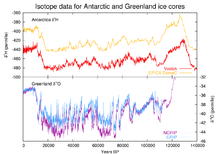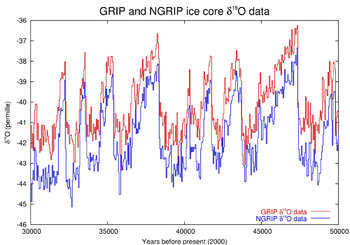- Dansgaard–Oeschger event
-
Dansgaard–Oeschger events (often abbreviated D–O events) are rapid climate fluctuations that occurred 25 times during the last glacial period. Some scientists (see below) claim that the events occur quasi-periodically with a recurrence time being a multiple of 1,470 years, but this is debated. The comparable climate cyclicity during the Holocene is referred to as Bond events.
Contents
Evidence
The best evidence for Dansgaard–Oeschger events remains in the Greenland ice cores, which only go back to the end of the last interglacial, the Eemian interglacial. Ice core evidence from Antarctic cores suggests that the Dansgaard–Oeschger events are related to the so-called Antarctic Isotope Maxima by means of a coupling of the climate of the two hemispheres, the Bi-polar Seesaw.[1] If this relationship holds also for the previous glacials, Antarctic data suggest that D-O events were present in previous glacial periods as well.
Effect
In the Northern Hemisphere, they take the form of rapid warming episodes, typically in a matter of decades, each followed by gradual cooling over a longer period. For example, about 11,500 years ago, averaged annual temperatures on the Greenland icepack warmed by around 8°C over 40 years, in three steps of five years (see,[2] Stewart, chapter 13), where a 5°C change over 30-40 years is more common.
Heinrich events only occur in the cold spells immediately preceding D-O warmings, leading some to suggest that D-O cycles may cause the events, or at least constrain their timing.[3]
The course of a D-O event sees a rapid warming of temperature, followed by a cool period lasting a few hundred years.[4] This cold period sees an expansion of the polar front, with ice floating further south across the North Atlantic ocean.[4]
Causes
The processes behind the timing and amplitude of these events (as recorded in ice cores) are still unclear. The pattern in the Southern Hemisphere is different, with slow warming and much smaller temperature fluctuations. Indeed, the Vostok ice core was drilled before the Greenland cores, and the existence of Dansgaard–Oeschger events was not widely recognised until the Greenland (GRIP/GISP2) cores were done; after which there was some reexamination of the Vostok core to see if these events had somehow been "missed".[verification needed]
The events appear to reflect changes in the North Atlantic ocean circulation, perhaps triggered by an influx of fresh water.[4]
The events may be caused by an amplification of solar forcings, or by a cause internal to the earth system - either a "binge-purge" cycle of ice sheets accumulating so much mass they become unstable, as postulated for Heinrich events, or an oscillation in deep ocean currents (Maslin et al.. 2001, p25).
Timing
Although the effects of the Dansgaard–Oeschger events are largely constrained to ice cores taken from Greenland,[5] there is evidence to suggest D-O events have been globally synchronous.[6] A spectral analysis of the American GISP2 isotope record [7] showed a peak of [18O:16O] abundance around 1500 years. This was proposed by Schulz (2002) [8] to be a regular periodicity of 1470 years. This finding was supported by Rahmstorf (2003);[9] if only the most recent 50,000 years from the GISP2 core are examined, the variation of the trigger is ±12% (±2% in the 5 most recent events, whose dates are probably most precise). However the older parts of the GISP2 core do not show this regularity, nor do the same events in the GRIP core. This may be because the first 50 kyr of the GISP2 core are most accurately dated, by layer counting. The climate system response to the trigger is varying within 8% of the period. Oscillations within the Earth system can be expected to be far more irregular in period. Rahmstorf suggests that the highly regular pattern would point more to an orbital cycle. Such a source has not been identified. The closest orbital cycle, a Lunar cycle of 1,800 years, cannot be reconciled with this pattern.[9] The dating between the European GRIP ice core and the American GISP2 ice core differs by about 5000 years at 50,000 years BP. It was noted by Ditlevsen et al. (2005) [10] that the spectral peak found in the GISP2 ice core was not present in the GRIP core, and thus depended critically on the accuracy of the dating. The dating issue was largely solved by the accurate dating of the NGRIP core.[11] Using this dating the recurrence of Dansgaard–Oeschger events is random consistent with a noise induced Poisson process.[12]
D-O cycles may set their own timescale. Maslin et al.. (2001) suggested that each ice sheet had its own conditions of stability, but that on melting, the influx of freshwater was enough to reconfigure ocean currents - causing melting elsewhere. More specifically, D-O cold events, and their associated influx of meltwater, reduce the strength of the North Atlantic Deep Water current (NADW), weakening the northern hemisphere circulation and therefore resulting in an increased transfer of heat polewards in the southern hemisphere. This warmer water results in melting of Antarctic ice, thereby reducing density stratification and the strength of the Antarctic Bottom Water current (AABW). This allows the NADW to return to its previous strength, driving northern hemisphere melting - and another D-O cold event. This theory may also explain Heinrich events' apparent connection to the D-O cycle; when the accumulation of meltwater in the oceans reaches a threshold, it may have raised sea level enough to undercut the Laurentide ice sheet - causing a Heinrich event and resetting the cycle.
The little ice age of ~400 to 200 years ago has been interpreted by some as the cold part of a D-O cycle.[4]
History
The ice core's signals now recognised as Dansgaard–Oeschger events are, in retrospect, visible in the original GISP core, as well as the Camp Century Greenland core [1]. But at the time the ice cores were made, their significance was noted but not widely appreciated. Dansgaard et al. (AGU geophysical monograph 33, 1985) note their existence in the GRIP core as "violent oscillations" in the δ18O signal, and that they appear to correlate to events in the previous Camp Century core 1 400 km away, thus providing evidence for their corresponding to widespread climatic anomalies (with only the Camp Century core, they could have been local fluctuations). Dansgaard et al. speculate that these may be related to quasi-stationary modes of the atmosphere-ocean system. D-O Events tend to be what drives the "Sahara pump" which has had an effect upon human evolution and dispersal.
The cyclicity is also found during the Holocene, where the events are referred to as Bond events.[13] [14]
See also
- 1500-year climate cycle
- Younger Dryas
References
- ^ Stocker, T. F., and S. J. Johnsen (2003). "A minimum thermodynamic model for the bipolar seesaw". Paleoceanography 18 (4): 1087. Bibcode 2003PalOc..18d..11S. doi:10.1029/2003PA000920. http://www.agu.org/pubs/crossref/2003/2003PA000920.shtml.
- ^ Alley, Richard B. (2000). "Ice-core evidence of abrupt climate changes". Proc. Natl. Acad. Sci. U.S.A. 97 (4): 1331–4. doi:10.1073/pnas.97.4.1331. PMC 34297. PMID 10677460. http://www.pnas.org/cgi/content/full/97/4/1331.
- ^ Bond, G.C.; Lotti, R. (1995-02-17). "Iceberg Discharges into the North Atlantic on Millennial Time Scales During the Last Glaciation". Science 267 (5200): 1005. doi:10.1126/science.267.5200.1005. PMID 17811441.
- ^ a b c d Bond, G.C., Showers, W., Elliot, M., Evans, M., Lotti, R., Hajdas, I., Bonani, G., Johnson, S., (1999). "The North Atlantic's 1–2 kyr climate rhythm: relation to Heinrich events, Dansgaard/Oeschger cycles and the little ice age". In Clark, P.U., Webb, R.S., Keigwin, L.D. (PDF). Mechanisms of Global Change at Millennial Time Scales. Geophysical Monograph. American Geophysical Union, Washington DC. pp. 59–76. ISBN 0-87590-033-X.
- ^ Dansgaard, W. et al. (1993). "Evidence for general instability of past climate from a 250-kyr ice-core record". Nature 364 (6434): 218–220. doi:10.1038/364218a0.
- ^ Voelker, Antje H.L. (2002). "Global distribution of centennial-scale records for Marine Isotope Stage (MIS) 3: a database". Quaternary Science Reviews 21: 1185–1212. doi:10.1016/S0277-3791(01)00139-1.
- ^ Grootes, P. M., and Stuiver, M. (1997). "Oxygen 18/16 variability in Greenland snow and ice with 10^-3 to 10^5-year time resolution". J. Geophys. Res. 102: 26 455–26 470. Bibcode 1997JGR...10226455G. doi:10.1029/97JC00880.
- ^ Schulz, M. (2002). "On the 1470-year pacing of Dansgaard–Oeschger warm events". Paleoceanography 17.
- ^ a b Stefan Rahmstorf (2003). "Timing of abrupt climate change: A precise clock" (PDF). Geophys. Res. Lett. 30 (10): 1510. Bibcode 2003GeoRL..30j..17R. doi:10.1029/2003GL017115. http://www.pik-potsdam.de/~stefan/Publications/Journals/rahmstorf_grl_2003.pdf.
- ^ Ditlevsen, P. D., Kristensen, M. S., and Andersen, K. K. (2005). The recurrence time of Dansgaard–Oeschger events and limits on the possible periodic component. 18. pp. 2594–2603.
- ^ Svensson, A. et al. (2006). "The Greenland Ice Core Chronology 2005, 15–42 ka. Part 2: Comparison to other records". QSR Shackleton special edition 25: 3258–3267.
- ^ Ditlevsen, P. D. et al. (2007). "The DO-climate events are probably noise induced: statistical investigation of the claimed 1470 years cycle". Clima. Past 3: 129–134. doi:10.5194/cp-3-129-2007.
- ^ Bond, G.; et al. (1997). "A Pervasive Millennial-Scale Cycle in North Atlantic Holocene and Glacial Climates" (PDF). Science 278 (5341): 1257–66. doi:10.1126/science.278.5341.1257. http://rivernet.ncsu.edu/courselocker/PaleoClimate/Bond%20et%20al.,%201997%20Millenial%20Scale%20Holocene%20Change.pdf.
- ^ Bond, G.; et al. (2001). "Persistent Solar Influence on North Atlantic Climate During the Holocene". Science 294 (5549): 2130–6. doi:10.1126/science.1065680. PMID 11739949.
- Maslin, M.; Seidov, D.; Lowe, J. (2001). "Synthesis of the nature and causes of rapid climate transitions during the Quaternary" (PDF). Geophysical Monograph 126: 9–52. http://www.essc.psu.edu/~dseidov/pdf_copies/maslin_seidov_levi_agu_book_2001.pdf. Retrieved 2008-03-06.
- Braun, Holger; et al. (2005). "Possible solar origin of the 1,470-year glacial climate cycle demonstrated in a coupled model". Nature (letter) 438 (7065): 208–211. doi:10.1038/nature04121. PMID 16281042.
- Schulz, Michael (2002). "On the 1470-year pacing of Dansgaard–Oeschger warm events" (PDF). Paleoceanography 17 (2): 1014. Bibcode 2002PalOc..17b...4S. doi:10.1029/2000PA000571. http://www.geo.uni-bremen.de/geomod/staff/mschulz/reprint/1470y_pacing.pdf.
External links
- Introduction to Physical Oceanography by Robert H. Stewart
- http://content.aip.org/products/esva/Dansgaard_Willi.html (subcription required) - Photo of Dansgaard and Oeschger in a sub ice trench at Dye-3
Categories:
Wikimedia Foundation. 2010.


